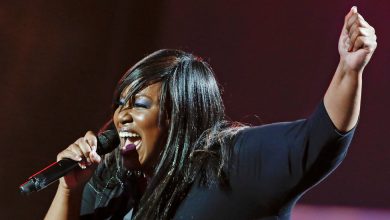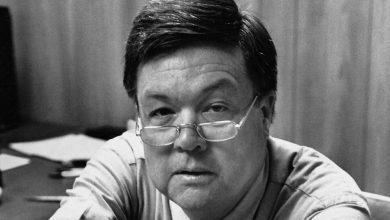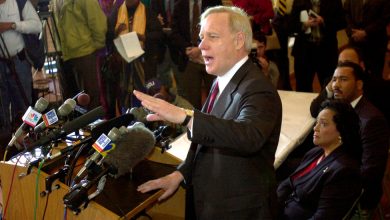The Secret Art of Turning a Concert Into a Film (Taylor’s Version)

Taylor Swift’s globe-spanning Eras Tour is one of the musical events of the year, drawing record-breaking crowds and making headlines the world over since it kicked off in Glendale, Ariz., in March. Rabid demand has made procuring a ticket notoriously difficult, if not practically impossible. But starting Friday, Swifties will have a more accessible opportunity to catch a glimpse of the live phenomenon, when the concert film “Taylor Swift: The Eras Tour” is released by AMC Theaters — a moviegoing event that is widely expected to be a box office smash.
Filmed over three nights in August at SoFi Stadium in Inglewood, Calif., and directed by Sam Wrench, “The Eras Tour,” like most concert films, aims to capture some of the magic of seeing the artist perform live. “The main thing we’re trying to do is provide the theatrical audience with the best seat in the house,” John Ross, the rerecording mixer on “The Eras Tour” and a veteran of many other hit concert films, including Jonathan Demme’s “Justin Timberlake + The Tennessee Kids,” said by phone. “If you were to attend a concert and get the premium seat, that’s my job, to convey that image sonically and situationally.”
But capturing a live performance is not as straightforward as simply setting up some cameras and microphones and recording what transpires onstage. The demands of a film are incredibly complicated, and faithfully reproducing the look and sound of a concert for the screen is an arduous and painstaking process for the filmmakers and their crews. It’s a delicate proposition — a proposition some filmmakers believe is inherently doomed.
“The idea itself, to film a concert, is a bad idea,” said Jonas Akerlund, a film and music video director who made the concert movies “On the Run Tour: Beyoncé and Jay-Z Live” and “Taylor Swift: The 1989 World Tour Live.”
He explained, “It will never, ever be as good as the live experience. It’s basically like trying to film fireworks — everybody knows that seeing it live is not the same as seeing it on a TV screen.” But, Akerlund added, the concert film can have value, if looked at in a different way. “You can make it an equally good experience, but it has to be a filmic or cinematic experience rather than trying to compete with the live experience.”
The secret to cinematic merit, he said, is having the time and means to shoot it like a proper movie. That means hiring upward of 40 camera operators; shooting over multiple nights; deploying drones, Spidercams and GoPros; and setting aside a separate dress rehearsal day, when the artist plays without a crowd to shoot extra footage, like close-ups that might not have been possible during the live show. All of the footage is assembled in the editing room “with the precision of a four-minute music video” to create the illusion that what you’re seeing was unfolding in real time. “I guess it’s cheating a little bit,” Akerlund said.
These kinds of cheats are common and, to hear filmmakers tell it, necessary. When the “Crazy Rich Asians” director Jon M. Chu made “Justin Bieber: Never Say Never,” he shot the performance and the audience on separate nights, then edited them together because that, paradoxically, made the audience’s reaction feel more authentic. “I always love concert films where it feels like the audience is really there,” he said. But because of the cameras, the sound recording equipment and the lighting, “audiences don’t react as big” as they would on an ordinary night. “You try to emulate what it feels like,” he said.
One of the most surprising things about the making of concert films is just how much tends to be emulated, even simulated, rather than merely captured as is. The actual sound of music being played live in an arena can’t merely be taped: “just a recording of the room would be useless,” Ross said. Instead, dozens of microphones — sometimes more than 100 for larger sites — record the vocals, instruments and crowd on separate tracks, and a rerecording mixer carefully blends them together, adding reverb and echo to simulate the sound of the space.
In other words, the tone of the room is essentially applied like a filter to the raw sounds recorded from the artist onstage. This filter, known as impulse response, takes readings from actual physical places, then “synthetically reproduces the sound of a real space like a club or stadium,” said Jake Davis, the lead mix engineer at SeisMic Sound, an audio facility in Nashville that specializes in concert films.
Mixers like Jake and his father, Tom Davis, the SeisMic founder, have a lot of control over the sound in a concert film, and making adjustments is a large part of their job. Some are minor refinements. Others are more like corrections: They make the concert film sound more like what the artist wanted than what necessarily occurred on the night it was filmed. “When you lock something down for a DVD or for streaming or whatever it is, once it’s done, it lives forever,” Tom Davis said. “It never goes away. So you kind of want it to be as good as it can be.”
Mixers can blend parts of a song recorded on one night with parts from another night to create the best combined version. They can fix an errant flat note in a guitar solo by manipulating it in postproduction, or they can ask an artist to rerecord a weak vocal in a studio, layering it into the mix so that it sounds as if it had been delivered live. “We copy, cut and paste, like you do on a word processor,” Davis said. “If there was a little clam in the first chorus, but he did it fine in the second chorus in the same part, we can cut and paste that. We can do vocal maintenance. We can fix a little pitch issue, or bend a note a little bit.”
Although sound mixers record the crowd with a bevy of microphones hidden around the arena, it’s possible — and indeed, common — to exaggerate the sound of that audience, to artificially give the cheering fans some extra kick. “It’s kind of a dirty secret,” Davis said. “But the sound of the real audience is weak. It’s not enough. You end up adding to it, pumping it up. There’s something psychological to hearing other humans having a good time and reacting — it’s like a sitcom and a laugh track.” Jake Davis said that the ideal balance is to “start with the real reaction” and then simply “make it bigger and more obvious.”
Of course, part of the appeal of a live show, even on film, is the impression of reality, and a sense of truth is critical. “The goal of the mix is to enhance the energy of the performance that exists as it went down in the best way possible,” Jake Davis said. “You maintain some element of rawness while taking out things that are distracting, the nuances of a wrong note or a background singer being a little bit off.”
While the film version strives to be “as good as it can be for the rest of history,” he said, “there’s a fine line between correcting something a little bit and making it perfect, because it’s not going to be perfect live.” It’s a bit like touching up a portrait in Photoshop: it’s tempting to clear blemishes, but too much airbrushing can make you look fake.
Paul Dugdale, the director of “Shawn Mendes: Live in Concert” and “Taylor Swift: Reputation Stadium Tour,” said that while some live shows might lend themselves to “maximum authenticity” as an approach, other huge pop concerts don’t emphasize the authentic in the same way. “For shows that are quite theatrical, there’s a level of artifice — they’ve got screens, they’ve got pyrotechnics, they’ve got costumes, all that kind of stuff,” he said. “For someone like Taylor, I think that allows you to explore further in terms of camera angles and putting the audience in different positions.”
A Swift concert, Dugdale pointed out, can last more than three hours, which affords the director more latitude in how to approach the film formally. “You can create texture just like the live show has texture,” he said. “Sometimes you can go heavy-handed with the director’s hand, and sometimes you can completely let go of the steering wheel and let the artist take over.”
Despite the high level of difficulty, the job for filmmakers and sound engineers is quite thankless. The best concert films will, to the unwitting viewer, seem like nothing more than filmed concerts — the filmmaking itself remains invisible.
“The goal is that you don’t want people thinking about the fact that this was worked on or changed at all from what it was live,” Jake Davis told me. “You just want the audience to be immersed in the experience and to accept that it’s happening in front of them — to feel like they’re there.”
But Dugdale noted that however much he tries to plan out a concert shoot, the live aspect will always prove unpredictable. “Making these films, you can be as prepared as you can possibly be, but in the end you have to hold on for dear life and see how it turns out.”



